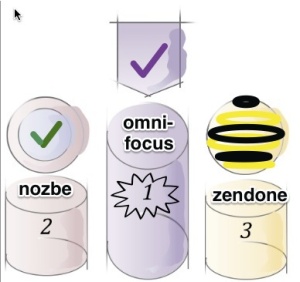
Finding a task management app that appeals and blends in with your working style can take quite some time. At some stage you have to make a choice, stick to it and make it work. Unless, of course, you really enjoy exploring new productivity apps. I find it fascinating that developers come up with so many different approaches to the questions of what do I want/have to do and what is the best way for planning and keeping track of all these activities.
While I have settled upon Omnifocus as my preferred task manager, I am virtually always exploring one or two other apps at the same time. Right now, I am tinkering with asana and Donedesk (if you subscribe to my blog you will be notified by email as soon as the respective reviews go live). Part of the attraction of entering tasks in a brand new app is the sense of exploration, coupled with a feeling of control: those first fifteen tasks stand there, neatly lined up, tagged and prioritised. They signal the new you, who will wake up clear-headed, have days of stellar achievement and seemingly effortlessly accomplish life goals… Any new app feels sleek and fast, like a regatta boat. By contrast, your trusted old task manager, with its hundreds of tasks collected over the years, can seem like a lumbering nineteenth-century frigate returning from a long ocean voyage, slowed down by the shroud of built-up seaweed on its keel.
It is not a fair comparison of course. Most promising new apps start revealing their flaws or limitations once you have used them for three or four weeks. For me, my ongoing struggle with Omnifocus has been how best to filter the multitude of my tasks in the absence of tags and using only the tools that are provided in the app: perspectives, start dates, due dates and flags. In this post I want to share my learning and workarounds with you in the hope that you will try, or stick with Omnifocus, which I consider the best productivity app around for Mac users. I am not in any way associated with the Omni Group.
If you are not a Mac user, or you want to look further afield, I recommend Priacta’s interactive table comparing productivity apps that are compatible with David Allen’s Getting Things Done® (GTD)® approach. Continue reading →
 Some task management apps seem inspired by steampunk: bells and whistles, lots of brass, faux leather, wood veneer and plenty of levers to throw. Others are light and fluid, almost zen–like in their barely there simplicity. Do not underestimate these ethereal apps, dear reader, for they may have a lot of potential bubbling away under the hood, ready for you to unleash.
Some task management apps seem inspired by steampunk: bells and whistles, lots of brass, faux leather, wood veneer and plenty of levers to throw. Others are light and fluid, almost zen–like in their barely there simplicity. Do not underestimate these ethereal apps, dear reader, for they may have a lot of potential bubbling away under the hood, ready for you to unleash.

 When I tried out
When I tried out 
